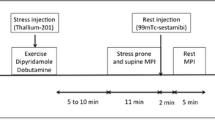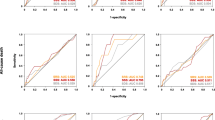Abstract
Purpose
The aim of this study was to ascertain whether stress myocardial perfusion imaging can independently predict long-term mortality.
Methods
We studied 1,386 patients with known or suspected coronary artery disease by means of stress 99mTc-tetrofosmin myocardial perfusion tomography. The end point during follow-up was death from any cause. Mortality rates were compared with that in a reference population using calculated age- and gender-specific data in the general population.
Results
Mean age was 60±11 years. There were 608 (44%) women. Perfusion abnormalities were fixed in 416 (30%) patients and reversible in 445 (32%) patients. During a mean follow-up of 6±1.9 years, 290 (21%) patients died. The annual mortality was 1.7% in patients with normal perfusion and 5.2% in patients with abnormal perfusion. Patients with multivessel distribution of perfusion abnormalities had the highest annual mortality (6.2%). The annual mortality in the reference population was 3.2%. In a multivariate analysis model, predictors of death were age [risk ratio (RR)=1.06, 95% CI 1.04–1.07], male gender (RR=2, CI 1.6–2.6), history of heart failure (RR=2.3, CI 1.8–3.1), diabetes mellitus (RR=2.1, CI 1.6–2.7), smoking (RR=1.8, CI 1.4–2.3), reversible perfusion defects (RR=1.8, CI 1.4–2.5) and fixed perfusion defects (RR=1.7, CI 1.3–2.1).
Conclusion
Myocardial perfusion abnormalities on stress 99mTc-tetrofosmin tomography are independently associated with long-term risk of death. The extent of perfusion abnormalities is a major determinant of mortality. The presence of normal perfusion is associated with a lower mortality compared with the general population.


Similar content being viewed by others
References
Klocke FJ, Baird MG, Lorell BH, Bateman TM, Messer JV, Berman DS, et al. American College of Cardiology; American Heart Association; American Society for Nuclear Cardiology. ACC/AHA/ASNC guidelines for the clinical use of cardiac radionuclide imaging—executive summary: a report of the American College of Cardiology/American Heart Association Task Force on Practice Guidelines (ACC/AHA/ASNC Committee to Revise the 1995 Guidelines for the Clinical Use of Cardiac Radionuclide Imaging). J Am Coll Cardiol 2003;42:1318–1333
Borges-Neto S, Tuttle RH, Shaw LK, Smith WT 4th, Jain D, Coleman RE, et al. Outcome prediction in patients at high risk for coronary artery disease: comparison between 99mTc tetrofosmin and 99mTc sestamibi. Radiology 2004;232:58–65
Calnon DA, McGrath PD, Doss AL, Harrell FE Jr, Watson DD, Beller GA. Prognostic value of dobutamine stress technetium-99m-sestamibi single-photon emission computed tomography myocardial perfusion imaging: stratification of a high-risk population. J Am Coll Cardiol 2001;38:1511–1517
Schinkel AF, Elhendy A, van Domburg RT, Bax JJ, Vourvouri EC, Bountioukos M, et al. Incremental value of exercise technetium-99m tetrofosmin myocardial perfusion single-photon emission computed tomography for the prediction of cardiac events. Am J Cardiol 2003;91:408–411
Iskander S, Iskandrian AE. Risk assessment using single-photon emission computed tomographic technetium-99m sestamibi imaging. J Am Coll Cardiol 1998;32:57–62
Hachamovitch R, Hayes SW, Friedman JD, Cohen I, Berman DS. A prognostic score for prediction of cardiac mortality risk after adenosine stress myocardial perfusion scintigraphy. J Am Coll Cardiol 2005;45:722–729
Berman DS, Hachamovitch R, Kiat H, Cohen I, Cabico JA, Wang FP, et al. Incremental value of prognostic testing in patients with known or suspected ischemic heart disease: a basis for optimal utilization of exercise technetium-99m sestamibi myocardial perfusion single-photon emission computed tomography. J Am Coll Cardiol 1995;26:639–647
Elhendy A, Bax JJ, Poldermans D. Dobutamine stress myocardial perfusion imaging in coronary artery disease. J Nucl Med 2002;43:1634–1646
Hachamovitch R, Berman DS, Kiat H, Cohen I, Cabico JA, Friedman J, et al. Exercise myocardial perfusion SPECT in patients without known coronary artery disease: incremental prognostic value and use in risk stratification. Circulation 1996;93:905–914
Beller GA, Zaret BL. Contributions of nuclear cardiology to diagnosis and prognosis of patients with coronary artery disease. Circulation 2000;101:1465–1478
Elhendy A, Schinkel AF, Van Domburg RT, Bax JJ, Valkema R, Poldermans D. Prognostic value of stress Tc-99m tetrofosmin SPECT in patients with previous myocardial infarction: Impact of scintigraphic extent of coronary artery disease. J Nucl Cardiol 2004;11:704–709
Jain D. Technetium-99m labeled myocardial perfusion imaging agents. Semin Nucl Med 1999;29:221–236.
Gottlieb SS. Dead is dead-artificial definitions are no substitute. Lancet 1997;349:662–663
Sorlie PD, Gold EB. The effect of physician terminology preference on coronary heart disease mortality: an artifact uncovered by the 9th revision ICD. Am J Public Health 1987;77:148–152
Kircher T, Anderson RE. Cause of death: proper completion of the death certificate. JAMA 1987;258:349–352
Zumwalt RE, Ritter MR. Incorrect death certification: an invitation to obfuscation. Postgrad Med 1987;81:245–254
Elhendy A, Schinkel AF, van Domburg RT, Bax JJ, Valkema R, Huurman A, et al. Risk stratification of patients with angina pectoris by stress 99mTc-tetrofosmin myocardial perfusion imaging. J Nucl Med 2005;46:2003–2008
Lowe LP, Greenland P, Ruth KJ, Dyer AR, Stamler R, Stamler J. Impact of major cardiovascular disease risk factors, particularly in combination, on 22-year mortality in women and men. Arch Intern Med 1998;158:2007–2014
Prescott E, Osler M, Andersen PK, Hein HO, Borch-Johnsen K, Lange P, et al. Mortality in women and men in relation to smoking. Int J Epidemiol 1998;27:27–32
Vaccaro O, Eberly LE, Neaton JD, Yang L, Riccardi G, Stamler J, et al. Impact of diabetes and previous myocardial infarction on long-term survival: 25-year mortality follow-up of primary screenees of the Multiple Risk Factor Intervention Trial. Arch Intern Med 2003;164:1438–1443
Hunt SA, Baker DW, Chin MH, Cinquegrani MP, Feldman AM, Francis GS, et al. ACC/AHA guidelines for the evaluation and management of chronic heart failure in the adult: executive summary. A report of the American College of Cardiology/American Heart Association Task Force on Practice Guidelines (Committee to revise the 1995 Guidelines for the Evaluation and Management of Heart Failure). J Am Coll Cardiol 2001;38:2101–2113
Iskander S, Iskandrian AE. Risk assessment using single-photon emission computed tomographic technetium-99m sestamibi imaging. J Am Coll Cardiol 1998;32:57–62
Elhendy A, Schinkel AF, van Domburg RT, Bax JJ, Valkema R, Poldermans D. Prediction of all-cause mortality in women with known or suspected coronary artery disease by stress technetium-99m tetrofosmin myocardial perfusion imaging. Am J Cardiol 2004;93:450–452
Marwick TH, Case C, Sawada S, Rimmerman C, Brenneman P, Kovacs R, et al. Prediction of mortality using dobutamine echocardiography. J Am Coll Cardiol 2001;37:754–760
Elhendy A, Mahoney DW, McCully RB, Seward JB, Burger KN, Pellikka PA. Use of a scoring model combining clinical, exercise test, and echocardiographic data to predict mortality in patients with known or suspected coronary artery disease. Am J Cardiol 2004;93:1223–1228
Biagini E, Elhendy A, Schinkel AF, Rizzello V, van Domburg RT, Krenning BJ, et al. Comparison of all-cause mortality in women with known or suspected coronary artery disease referred for dobutamine stress echocardiography with normal versus abnormal test results. Am J Cardiol 2005;95:1072–1075
Acknowledgement
This study was supported in part with a publication grant from GE Health Care.
Author information
Authors and Affiliations
Corresponding author
Rights and permissions
About this article
Cite this article
Elhendy, A., Schinkel, A.F.L., van Domburg, R.T. et al. Prognostic value of stress 99mTc-tetrofosmin myocardial perfusion imaging in predicting all-cause mortality: a 6-year follow-up study. Eur J Nucl Med Mol Imaging 33, 1157–1161 (2006). https://doi.org/10.1007/s00259-006-0140-4
Received:
Revised:
Accepted:
Published:
Issue Date:
DOI: https://doi.org/10.1007/s00259-006-0140-4




